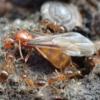https://link.springe...-017-4007-0.pdf
Abstract:
Historic and current land-use changes have altered the landscape for grassland biota, with over 90% of grasslands and savannas converted to agriculture or some other use in north temperate regions. Reintegrating grasslands into agricultural landscapes can increase biodiversity while also providing valuable ecosystem services. In contrast to their well-known importance in tropical and subtropical ecosystems, the role of ants in temperate grasslands is often underappreciated. As consumers and ecosystem engineers, ants in temperate grasslands influence invertebrate, plant, and soil microbial diversity and potentially alter grassland productivity. As common and numerically dominant invertebrates in grasslands, ants can also serve as important indicator species to monitor conservation and management practices. Drawing on examples largely from mesic, north temperate studies, and from other temperate regions where necessary, we review the roles of ants as consumers and ecosystem engineers in grasslands. We also identify five avenues for future research to improve our understanding of the roles of ants in grasslands. This includes identifying how grassland fragmentation may influence ant community assembly, quantifying how ant communities impact ecosystem functions and soil processes, and understanding how ant communities and their associated interactions are impacted by climate change. In synthesizing the role of ants in temperate grasslands and identifying knowledge gaps, we hope this and future work will help inform how land managers maximize grassland conservation value while increasing multiple ecosystem services and minimizing disservices.
I was surprised to read that Aphaenogaster rudis occurs in grasslands, though not that Formica subsericea took seeds a greater distance than them. Not many sun loving grasses and forbs (wildflowers) love have elaiosome (ant food) on their seeds compared to spring blooming ephemerals.















